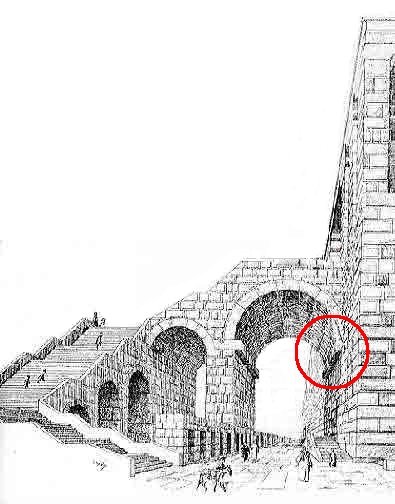
The name given to the stump of an arch found half-way up on the Western Wall close to the south-west corner of the Herodian Temple Mount. It is named after the American Bible scholar Edward Robinson, who first identified it in 1839. It was once thought to be part of a bridge connecting the Royal Stoa to the Upper City: one of the four gates along the western wall mentioned by Josephus. Archaeological explorations directed by Benjamin Mazar have proved that wrong; it is the remains of a stair-case that descend to the street below and running alongside the western wall.
See Where ☰


Artist's impression of the gate; Robinson's Arch is circled.
Like most of the Herodian temple, it was destroyed during the First Jewish Revolt. Some of its remains (esp. the pier that held it up), together with the great stone blocks from the upper tiers of the temple wall, can be seen below the Arch; the force of their impact as they crush down can be seen in the broken up pavement stones. The street continues—buried—beneath the wall in the background (part of the ramp that today leads up to the entrance to the Temple Mount) and beneath the present Western Wall. Southwards, it is believed, the street very likely continued south into the Tyropoeon Valley and the Lower City.

The street below Robinson's Arch.

An ancient street under excavation in the Tyropoeon Valley that may be a continuation from that at the Western Wall.
Among the debris was an ashlar (dressed stone) inscribed with the words, "To the trumpeting place to . . ." The original is now in the Israel Museum; a replica is, however, found in situ.

The replica ashlar with Hebrew inscription.
Reconstruction of the missing line suggests that the entire sentence probably read, "To the trumpeting place to distinguish between the sacred [Sabbath] and the proface [weekdays]," suggesting that the south-western corner of the Royal Stoa was where, according to Josephus, "it was the custom for one of the priests to stand and to give notice, by sound of trumpet, in the afternoon of the approach, and on the following evening of the close, of every seventh day, announcing to the people the respective hours for ceasing work and for resuming their labours" (Jewish War 4.9.12). A location immediately above the arched gateway would have been ideal for such a summoning of the faithful.

This photo from 1935 shows how much debris had covered the city since New Testament times. Robinson's Arch is circled.

©ALBERITH
190415lch